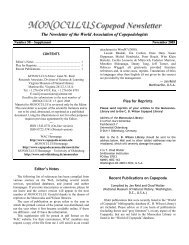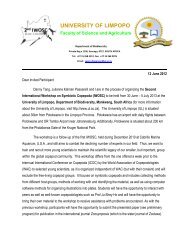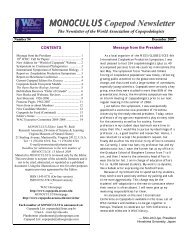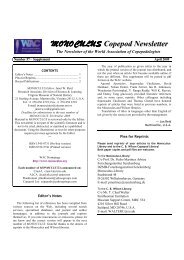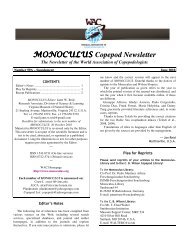MONOCULUS Copepod Newsletter - World Association of ...
MONOCULUS Copepod Newsletter - World Association of ...
MONOCULUS Copepod Newsletter - World Association of ...
Create successful ePaper yourself
Turn your PDF publications into a flip-book with our unique Google optimized e-Paper software.
y an increase in general interest and funding acrossresearch disciplines. The latter observation with respect t<strong>of</strong>unding follows from the increasing realisation that genomicand proteomic studies must eventually be rooted in classicalbiological disciplines, in order to draw sense from theoverwhelming quantities <strong>of</strong> data generated by currenttechnologies.There are a number <strong>of</strong> strategies for establishing genomicresources for any organism or group <strong>of</strong> organisms. The mostcomplete and expensive approach, is to sequence the fullgenomic DNA <strong>of</strong> the organism, which comprises both thecoding (principally DNA that is transcribed into mRNA andtranslated into proteins) and non-coding regions (regions thatdo not contain instructions for proteins). Non-codingsequences contain regions <strong>of</strong> DNA involved in theregulation <strong>of</strong> coding regions as well as “junk DNA” (DNAwith no currently understood function). Full genomesequencing provides: 1) a picture <strong>of</strong> the total geneticcapabilities <strong>of</strong> an organism; 2) full-length sequences forgenes; 3) information on the relationship <strong>of</strong> genes and thestructural and control elements that are associated withthem; 4) a template for interpreting sequences deriving fromthe same or different taxa; and 5) potentially unexpecteddiscoveries on genomic architecture and molecularevolution. Alternatively, a second and substantially lessexpensive strategy is to sequence a large number <strong>of</strong> ESTs(Expressed Sequence Tags) from cDNA libraries. A cDNAlibrary <strong>of</strong> an organism (or tissue there<strong>of</strong>) contains themajority <strong>of</strong> the genomic information that is required for theproduction <strong>of</strong> all <strong>of</strong> its proteins under a defined set <strong>of</strong>conditions. Such a library is representative <strong>of</strong> the“transcriptome” <strong>of</strong> the organism, i.e., those genes that areactively being transcribed into the proteins / peptidesrequired under a given set <strong>of</strong> physiological / environmentalconditions or at a particular moment in the organism’s lifecycle.In functional studies ESTs are <strong>of</strong>ten considered to bemore targeted and therefore more efficient than the fullgenome approach. However, to ensure good representation<strong>of</strong> all <strong>of</strong> the genes within a genome, these studies must beconducted on cDNA libraries constructed for the widestpossible range <strong>of</strong> biological states, e.g., life-history stages,sexes, temperatures, nutritional states, etc. Thedisadvantages <strong>of</strong> this approach are: 1) that information onthe structure and organization <strong>of</strong> the genome, genetic regionsresponsible for gene control and the full genetic capacity <strong>of</strong>the organism will be lacking; and 2) that the sequencesobtained will be partial, so that a full-length sequence forany given gene must further be determined. The full genomestrategy can perhaps be considered to be more generic thanother approaches; however, such an approach is not onlyextremely expensive but also provides data from only asingle or limited number <strong>of</strong> individuals <strong>of</strong> a single species.Whilst having a full genome sequence <strong>of</strong> any given copepodwould greatly facilitate the genome sequencing <strong>of</strong>subsequent copepod species by providing a scaffold for6assembly, and a template for annotation, it is worth notingthat assembly and annotation <strong>of</strong> a full genome itself reliesupon the prior existence <strong>of</strong> extensive EST and othersequence resources (e.g., cosmid and bacterial artificialchromosome (BAC) libraries).The ideal approach probably comprises a combination <strong>of</strong>these two major strategies: sequencing the full genome <strong>of</strong> asingle selected species, while building large EST libraries(>150,000 ESTs) for a variety <strong>of</strong> species <strong>of</strong> interest.Current status <strong>of</strong> genomic resourcesAs can be seen from Table 1, only limited nucleotide andproteomic resources currently exist in the public domain forany species <strong>of</strong> copepod, and those nucleotides that do existcomprise principally 4-5 targets that are routinely used forphylogenetic studies, e.g., 18S, ITS. Further sequences existin private libraries; however, such collections do not directlybenefit the larger community. The cost <strong>of</strong> full genomesequencing depends largely upon the actual genome size <strong>of</strong>the organism to be sequenced. For those copepods listed inpublicly accessible databases, genome sizes range from anestimated 137 Mb (million base pairs) for Cyclops kolensisto 12,186 Mb for Calanus hyperboreus. These figurescompare to the human genome, which is estimated at 3,423Mb, and that <strong>of</strong> the fruit fly D. melanogaster, which isestimated at 180 Mb (Gregory 2006).Table 1. Nucleotide and protein sequences for metazoan species inpublic-access databases, illustrating the poor representation <strong>of</strong><strong>Copepod</strong>a relative to their importance as a group (data from NCBITaxonomy Browser, 20/08/06).Nucleotide Sequences Protein SequencesMetazoa 55,865,421 1,561,653Vertebrata 47,788,354 1,113,542Arthropoda 3,890,583 285,984Hexapoda 3,669,110 261,429Crustacea 104,269 14,252Malacostraca 82,565 8,363<strong>Copepod</strong>a 2,677* 1,582*Calanoida 853, Cyclopoida 258, Harpacticoida 522,Poecilostomatoida 145, Siphonostomatoida 867.Selection <strong>of</strong> model speciesFor the full genome sequencing approach, the expenseinvolved ensures that very few copepod species can bechosen for sequencing. When asked to suggest the idealmodel species, most researchers will immediately make agood case for the species they work on (using the “myspecies is best” criterion); however, in order to provide acommunity-wide resource, it is essential to consider a widerrange <strong>of</strong> criteria upon which to base such a critical decision.



